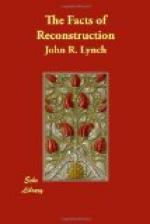Fifth. Notwithstanding the immense increase in the value of taxable property, and in spite of the enormous sums paid into the State Treasury each year, there has been a material increase in the bonded debt of the State. In fact it has been necessary at different times to borrow money with which to pay the current expenses of the State Government.
The following statistics for three years, 1907, 1908 and 1909, would seem to substantiate the above statement:
The value of the taxable property of the State in 1907 was $373,584.960. Receipts from all sources that year were $3,391,127.15. Disbursements for the same period were $3,730,343.29. Excess of disbursements over receipts, $339,216.14.
In 1908 the value of taxable property was $383,823,739. Receipts from all sources that year were $3,338,398.98. Disbursements, same period, $3,351,119.46. Excess of disbursements over receipts, $12,720.48.
In 1909 the value of taxable property was $393,297,173. Receipts from all sources were $3,303,963.65. Disbursements, same period, $3,315,201.48. Excess of disbursements over receipts, $11,237.83.
On the first day of January, 1907, what is called the payable debt of the State was reported to be $1,253,029.07. On the first day of January, 1876, it was $520,138.33. Increase, $732,890.74.
CHAPTER IX
What constitutes “Negro domination”
It is claimed that in States, districts, and counties, in which the colored people are in the majority, the suppression of the colored vote is necessary to prevent “Negro Domination,”—to prevent the ascendency of the blacks over the whites in the administration of the State and local governments.
This claim is based upon the assumption that if the black vote were not suppressed in all such States, districts, and counties, black men would be supported and elected to office because they were black, and white men would be opposed and defeated because they were white.
Taking Mississippi for purposes of illustration, it will be seen that there has never been the slightest ground for such an apprehension. No colored man in that State ever occupied a judicial position above that of Justice of the Peace and very few aspired to that position. Of seven State officers only one, that of Secretary of State, was filled by a colored man, until 1873, when colored men were elected to three of the seven offices,—Lieutenant-Governor, Secretary of State, and State Superintendent of Education. Of the two United States Senators and the seven members of the lower house of Congress not more than one colored man occupied a seat in each house at the same time. Of the thirty-five members of the State Senate, and of the one hundred and fifteen members of the House,—which composed the total membership of the State Legislature prior to 1874,—there were never more than about seven colored men in the Senate and forty in the lower house. Of the ninety-seven members that composed the Constitutional Convention of 1868 but seventeen were colored men. The composition of the lower house of the State Legislature that was elected in 1871 was as follows:




